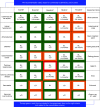The effect of comorbidities on the choice of tyrosine kinase inhibitors in patients with chronic myeloid leukemia
- PMID: 35664044
- PMCID: PMC9136639
- DOI: 10.2217/ijh-2021-0010
The effect of comorbidities on the choice of tyrosine kinase inhibitors in patients with chronic myeloid leukemia
Abstract
Tyrosine kinase inhibitors (TKIs) approved for chronic myeloid leukemia known to have similar efficacies but different safety profiles. Therefore, the choice of patient-specific treatments is driven by factors such as tolerability and adverse event profile of TKIs. This review article examines the most up-to-date data and provides practical recommendations for clinical approaches. Nilotinib and ponatinib should be avoided in patients with cardiovascular risk factors, dasatinib in patients with lung damage and bosutinib and nilotinib in patients with liver disease. Considering that certain comorbidities predispose some patients to developing severe adverse events when receiving TKIs, the first- and second-line treatment of chronic myeloid leukemia should be tailored to each patient's individual condition.
Keywords: adverse event; chronic myeloid leukemia; comorbidity; drug toxicity; interactions (drug–drug); safety; tolerability; tyrosine kinase inhibitor.
© 2022 Guray Saydam and all co-authors.
Conflict of interest statement
Financial & competing interests disclosure All authors received an honorarium from Pfizer in connection with the development of this study. G Saydam has acted in advisory board of Novartis, AbbVie, Amgen, Pfizer Pharmaceuticals and Bristol Myers Squibb and has received speaker honorarium from Novartis. R Ali has acted in advisory board of Novartis, Amgen, Pfizer Pharmaceuticals and Bristol Myers Squibb and has received speaker honorarium from Novartis, Amgen and Pfizer Pharmaceuticals. AM Demir has acted in advisory board of Novartis, AbbVie, Amgen, Pfizer Pharmaceuticals and Bristol Myers Squibb and has received speaker honorarium from Novartis. AE Eskazan has acted in advisory board of Novartis and Pfizer Pharmaceuticals, and has received speaker honorarium from Pfizer Pharmaceuticals, Bristol Myers Squibb and Novartis. B Guvenc has acted in advisory board of Novartis, AbbVie, Amgen, Pfizer Pharmaceuticals and Bristol Myers Squibb and has received speaker honorarium from Novartis. IC Haznedaroglu has acted in advisory board of Novartis, Pfizer Pharmaceuticals and Bristol Myers Squibb and has received speaker honorarium from Novartis. MA Ozcan has acted in advisory board of Novartis, AbbVie, Amgen, Pfizer Pharmaceuticals, and Bristol Myers Squibb and has received speaker honorarium from Novartis. O Salim has acted in advisory board of Novartis, AbbVie, Amgen, Pfizer Pharmaceuticals and Bristol Myers Squibb. M Sonmez has acted in advisory board of Novartis, AbbVie, Amgen, Pfizer Pharmaceuticals and Takeda and has received speaker honorarium from Novartis. M Turgut has acted in advisory board of Novartis, Pfizer Pharmaceuticals, and Bristol Myers Squibb and has received speaker honorarium from Novartis. ATT has acted in advisory board of Novartis, AbbVie, Pfizer Pharmaceuticals, and Takeda and has received speaker honorarium from these companies. A Unal has acted in advisory board of Novartis, AbbVie, Amgen, and Bristol Myers Squibb and has received speaker honorarium from Novartis. S Bozkurt, B Aver and B Ozdengulsun are employees in Pfizer Pharmaceuticals. O İlhan has acted in advisory board of Novartis, AbbVie, Amgen, Pfizer Pharmaceuticals, Bristol Myers Squibb, Janssen Pharmaceutical, Deva Holding, Nobel Ilac and Roche. The authors have no other relevant affiliations or financial involvement with any organization or entity with a financial interest in or financial conflict with the subject matter or materials discussed in the manuscript apart from those disclosed. Medical Writing support was provided by Ayşe Özlem Yılmaz and submission assistance was provided by İlknur Kehlibar at Remedium Consulting Group and was funded by Pfizer.
Figures
References
-
- Pfirrmann M, Baccarani M, Saussele S et al. Prognosis of long-term survival considering disease-specific death in patients with chronic myeloid leukemia. Leukemia 30(1), 48–56 (2016). - PubMed
-
- Jabbour E. Chronic myeloid leukemia: first-line drug of choice. Am. J. Hematol. 91(1), 59–66 (2016). - PubMed
-
- Deininger MW, Shah NP, Altman JK et al. Chronic Myeloid Leukemia, Version 2.2021, NCCN Clinical Practice Guidelines in Oncology. J. Natl Compr. Canc. Netw. 18(10), 1385–1415 (2020). - PubMed
-
• According to this guideline the selection of first-line tyrosine kinase inhibitors (TKI) therapy (bosutinib, dasatinib, imatinib or nilotinib) in a given patient should be based on the risk score, toxicity pro-file of TKI, patient’s age, ability to tolerate therapy and the presence of comorbid conditions.
-
- Muresan B, Mamolo C, Cappelleri JC, Shapiro M. Matching-adjusted indirect treatment comparison of bosutinib, dasatinib, nilotinib and ponatinib on survival for second line chronic phase chronic myeloid leukemia patients. Blood 128(22), 3095(2016).
-
- Valent P, Hadzijusufovic E, Schernthaner GH et al. Vascular safety issues in CML patients treated with BCR/ABL1 kinase inhibitors. Blood 125(6), 901–906 (2015). - PubMed
Publication types
LinkOut - more resources
Full Text Sources

